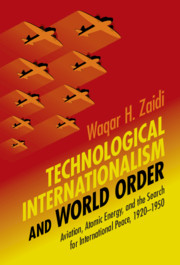 Technological Internationalism and World Order
Technological Internationalism and World Order Book contents
- Technological Internationalism and World Order
- Science in History
- Technological Internationalism and World Order
- Copyright page
- Dedication
- Contents
- Figures
- Acknowledgements
- Abbreviations
- Introduction: Machines of Peace
- 1 Invention, Interdependence, and the Lag
- 2 Controlling Scientific War
- 3 The Shape of Things to Come
- 4 Air Power for a United Nations
- 5 Wings for Peace: Planning for the Post-War Internationalization of Civil Aviation
- 6 A Battle for Atomic Internationalism: United States and the International Control of Atomic Energy
- 7 A Blessing in Disguise: Britain and the International Control of Atomic Energy
- Conclusion: Science, Technology, and Internationalism into the Cold War and Beyond
- Bibliography
- Index
7 - A Blessing in Disguise: Britain and the International Control of Atomic Energy
Published online by Cambridge University Press: 25 May 2021
- Technological Internationalism and World Order
- Science in History
- Technological Internationalism and World Order
- Copyright page
- Dedication
- Contents
- Figures
- Acknowledgements
- Abbreviations
- Introduction: Machines of Peace
- 1 Invention, Interdependence, and the Lag
- 2 Controlling Scientific War
- 3 The Shape of Things to Come
- 4 Air Power for a United Nations
- 5 Wings for Peace: Planning for the Post-War Internationalization of Civil Aviation
- 6 A Battle for Atomic Internationalism: United States and the International Control of Atomic Energy
- 7 A Blessing in Disguise: Britain and the International Control of Atomic Energy
- Conclusion: Science, Technology, and Internationalism into the Cold War and Beyond
- Bibliography
- Index
Summary
Chapter Seven focuses on postwar Britain and highlights the liberal nature of postwar atomic internationalism by examining responses to the bomb from across the political spectrum. The chapter explores media coverage as well as positions taken by prominent intellectuals; particularly liberals Arthur Salter and Bertrand Russell, realists such as Lord Hankey, and the leftist perspective developed by physicist Patrick Blackett. The chapter also argues that long-established liberal internationalist organizations such as the New Commonwealth Society and the United Nations Association were more crucial to the propagation of proposals for international control than the scientists’ associations emphasized in existing histories of the period.
- Type
- Chapter
- Information
- Technological Internationalism and World OrderAviation, Atomic Energy, and the Search for International Peace, 1920–1950, pp. 212 - 238Publisher: Cambridge University PressPrint publication year: 2021
